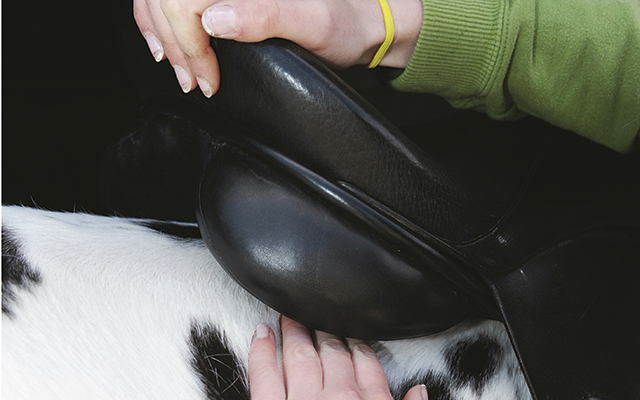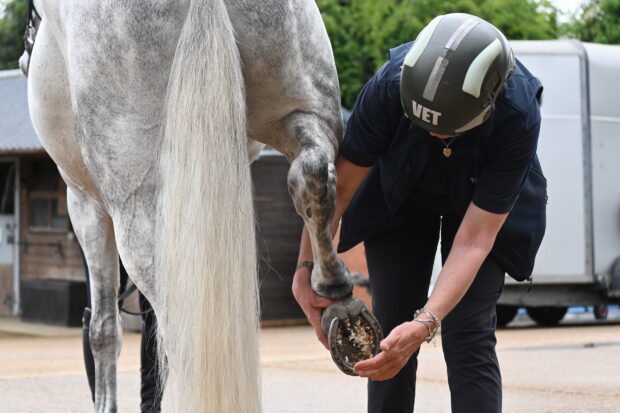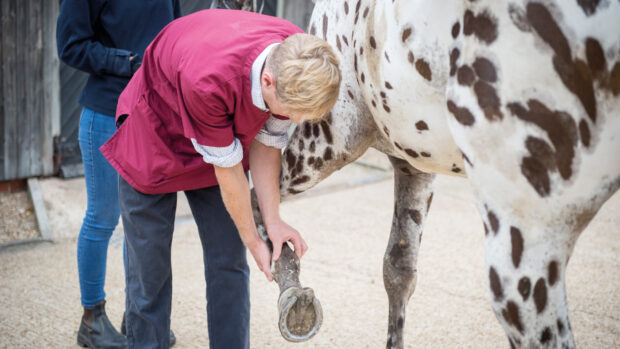All horses can develop problems, but some are easier to investigate than others.
If your horse goes lame on a front leg, at least the vet knows where to start looking. But what if a horse just doesn’t seem happy being ridden? He might refuse to go forward, nap or even rear. Is he in pain, or simply trying it on?
When he tenses and bucks if you put your legs on, does that signify discomfort, or just a reluctance to listen? The snapped-back ears and tail swishing when you mount — is that oversensitivity or a sign of something more sinister?
No horse behaves perfectly all the time, so how do you distinguish between a genuine reaction to pain and simple bad behaviour? The owner is often convinced the problem is solely physical, but the reality is often both more complicated and more interesting.
Who’s in charge?
The first step to any investigation is to take a detailed history from the owner.
Simple questions such as how long they have owned the horse are often revealing. With a new horse there is typically a honeymoon period of a few weeks or months before he begins to test the limits of what is allowed.
Age is significant: a young horse may still be green, an old one already stiffening up. Owner experience and expectation are also important, particularly when the two are not evenly matched.
The same is true of the horse. Sometimes, problems appear only when a horse is asked to go up to a level that is out of his comfort zone or exceeds his ability. Frequency and amount of work also have a bearing. A horse may be in the field all week and only pulled out to compete at the weekend, while at the other end of the scale some horses grind around the school for hours each day, becoming bored
and stale.
If, however, horse and rider have been operating well as a unit for some time before problems develop, then these are much more likely to be pain-related.
The examination of the horse comes next and should start with his body language and expression.
A lot can be learned from the look in a horse’s eye and general expression, while the way he behaves with his owner will soon tell you who is really in charge.
This is followed by an assessment of conformation, looking for weak points that may be sources of pain when he is ridden. Is he poorly muscled behind the saddle, for example, which may point to sacroiliac issues, or very straight in the hindleg, which could be linked to suspensory injuries? It is important to assess soundness thoroughly, which means walking and trotting the horse in hand, followed by flexion tests, lungeing in trot on a hard surface and then lungeing in trot and canter in the arena.
Tack and saddle fit should also be assessed. After this he should be seen mounted and ridden at all paces by the usual rider. All this takes time, but is essential for building up a full picture.
Hopefully, the problem behaviour will be displayed. Horses are often irritatingly well behaved while the vet is there, however, so a video of previous performance can be useful.
By the time such an examination has been completed it may be clear that there is an underlying focus of pain. There could be an actual lameness in one or more legs, or a more subtle finding such as toe drag or a shortened stride.
But is such a finding significant? We know that a lot of horses have at least some degree of lameness — up to 50% in one study — but this doesn’t always result in behavioural issues. Some horses are very stoical and continue to work despite low-grade discomfort, whereas others will not.
The most common way to try and prove that pain is responsible is by performing nerve blocks — injecting local anaesthetic around the nerves to a particular area.
If both the lameness and the behaviour are improved, this is strong evidence that the problem is primarily physical.
At other times the only option is a “bute trial” — a period of in-feed painkillers given to see if there is a positive effect.

A second opinion
One of the major causes of behavioural issues is a lack of rider competence, particularly at more novice levels.
The horse may be misbehaving because the rider is inexperienced, over-horsed or scared. Sometimes it is less an issue of the rider’s nerve than their balance, aids and contact.
It can be extremely useful to see the horse ridden by a professional. This not only gives the vet a chance to evaluate the effect of different riding, but also to get another opinion from on board.
It is no surprise if a horse goes better for somebody more skilled, but what is important is trying to determine if the normal rider is the principal cause of the problem. If they are, no vet is going to be able to make things better!
The final aspect to consider is the temperament of the horse. While most horses are generally willing to please, they all have individual characters and opinions, and will test the boundaries of behaviour at times.
The detailed history can often give clues: if the behaviour is only seen when working in the arena, perhaps, but never when out on a fun hack. If boundaries are not maintained — for example, if the rider stops and gets off when the horse naps or shies — then bad behaviour is rewarded and reinforced.
Changing the normal routine, working with an experienced trainer or even sending the horse away to another yard are all ways that a rider can take command again.
Solving challenging behaviour is rarely easy. Often, there is pressure on vets to perform ever more tests in the search for an answer. It is easier for everyone to have a physical problem to blame than for an owner to accept that they may have bought the wrong horse or lost their confidence.
No vet or owner would want to work a horse that is in pain, so it is important that all behavioural cases are thoroughly investigated. It can be a lengthy process, however, and the final conclusion is often that there is a combination of physical and behavioural factors.
If pain is 90% of the problem and the resulting behaviour only 10%, then treatment may be possible. If such a ratio is reversed, the outlook is a lot less certain.
Beware red herrings
Many horses are gastroscoped to check for ulcers, or have their backs X-rayed in case of kissing spines. Both of these conditions can cause poor performance and behavioural problems and neither can be ruled out without these extra tests.
The results, however, are often not as black or white as we would like.
Take ulcers as an example. Published studies have shown that 80-100% of thoroughbred racehorses in training have a degree of gastric ulceration, while in sport horses the figure is still somewhere between 30% and 50%. Yet if half of horses competing have ulcers, why isn’t the level of behavioural issues similarly high?
The answer is that the severity of ulcers varies, and so does the individual response to it. Horses with only mild ulceration often show no clinical signs, so an apparently positive finding in a horse with behavioural issues may be a red herring and not necessarily the true cause of the problem.
Ref: Horse & Hound; 23 June 2016




